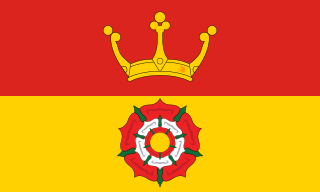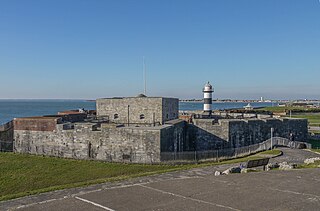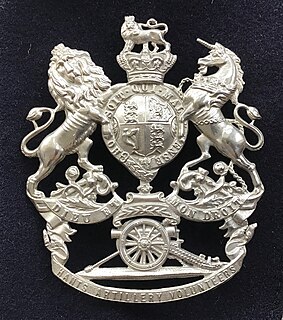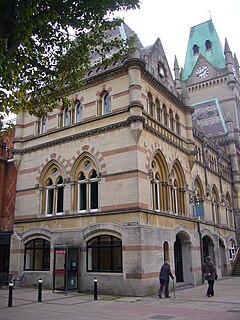
Portsmouth City Police was the city force for Portsmouth, Hampshire [1] from 1836 to 1967. [2]

Portsmouth City Police was the city force for Portsmouth, Hampshire [1] from 1836 to 1967. [2]
The history of crime prevention in Portsmouth dates back to the 13th Century. [3] Parish constables are again recorded in 1435, 1531 and 1621. By the early 18th century the city had 155 public houses, a number that was to grow steadily as the Royal Navy presence in the town grew ever larger.
At a meeting on 25 January 1836 a committee was formed to decide on the size of the city's own police service. The first officers were sworn in on 18 March that year. The initial strength was 40 men.
Portsmouth decided to appoint 1919 its first women police in 1919 when three were hired. [5] In 1922 it changed course return to being an all male force. [5] Portsmouth would again begin employing women police in 1947. [6] The first women sergeant was promoted to that position in 1952 and the first to reach inspector rank was promoted in 1963. [6]
On 31 March 1967 the force ceased to exist and was amalgamated into the newly formed Hampshire Constabulary. The final strength was 550 people.
| Name | Rank | Years served |
|---|---|---|
| Captain Robert Elliott (82nd Regiment of Foot) | Superintendent | 1839 to 1848 |
| William Leggatt | Superintendent | 1848 to 1859 |
| Thomas Hayter Chase | Chief Officer | 1859 to 1860 |
| Richard Barber | Chief Officer | 1860 to 1875 |
| James Jervis | Chief Constable | 1875 to 1880 |
| Alfred William Cosser [7] | Chief Constable | 1880 to 1893 |
| John Messier [8] | Chief Constable | 1893 to 1898 |
| Arthur Prickett | Chief Constable | 1898 to 1907 |
| Thomas Davies | Chief Constable | 1907 to 1940 |
| Arthur Charles West [9] | Chief Constable | 1940 to 1958 |
| William Newick Wilson | Chief Constable | 1958 to 1964 |
| Owen Flynn | Chief Constable | 1964 to 1967 |

Hampshire is a county in South East England on the coast of the English Channel. The county town is Winchester, but the county is named after Southampton. Its two largest cities are Southampton and Portsmouth which are administered separately as unitary authorities; the rest of the county is governed by a combination of the Hampshire County Council and non-metropolitan district councils.

Portsmouth is a port and city in the county of Hampshire in southern England. The city of Portsmouth is a unitary authority, which is administered by Portsmouth City Council.

Southsea is a seaside resort and a geographic area of Portsmouth, Portsea Island in England. Southsea is located 1.8 miles (2.8 km) to the south of Portsmouth's inner city-centre. Southsea is not a separate town as all of Portsea Island's settlements were incorporated into the boundaries of Portsmouth in 1904.

Southsea Castle, historically also known as Chaderton Castle, South Castle and Portsea Castle, is an artillery fort originally constructed by Henry VIII on Portsea Island, Hampshire, in 1544. It formed part of the King's Device programme to protect against invasion from France and the Holy Roman Empire, and defended the Solent and the eastern approach to Portsmouth. The castle had a square central keep, two rectangular gun platforms to the east and west, and two angled bastions to the front and rear, and was an early English example of the trace italienne-style of fortification popular on the Continent. The Cowdray engraving of the Battle of the Solent in 1545 depicted Henry VIII visiting the castle. Despite several serious fires, it remained in service and saw brief action at the start of the English Civil War in 1642 when it was stormed by Parliamentary forces.

Colonel Sir Arthur Edwin Young was a British police officer. He was Commissioner of Police of the City of London from 1950 to 1971 and was also the first head of the Royal Ulster Constabulary to be styled Chief Constable. Young was instrumental in the creation of the post of Chief Inspector of Constabulary. In the early 1950s, he played a crucial role in policing decolonisation in the British Empire. During the 1960s, he led the way in modernising British police recruitment and in improving the training of senior officers.

The Southsea Railway was a branch of the Portsmouth Direct Line, located on Portsea Island, Hampshire in the United Kingdom. The railway was opened on 1 July 1885 and closed on 6 August 1914.

Portsmouth & Southsea railway station is a Grade II listed building and the main railway station in the Landport area of the city of Portsmouth in Hampshire, England. It is close to the Commercial Road shopping area. British Transport Police maintain a presence at the station. There is a taxi rank at the front of the building and regular local buses within five minutes' walking distance.

Hampshire Constabulary is the territorial police force responsible for policing the counties of Hampshire and the Isle of Wight in South East England, United Kingdom.
Sir Douglas Osmond was the chief constable of Shropshire Constabulary and later Hampshire Constabulary. He is regarded as one of the first career chief constables in the UK.

The Hampshire and Isle of Wight Fire and Rescue Service (HIWFRS) is the statutory fire and rescue service for the county of Hampshire, including the cities of Southampton and Portsmouth, and the county of the Isle of Wight on the south coast of England. The service was formed on 1 April 2021 from the merger of Hampshire Fire and Rescue Service and the Isle of Wight Fire and Rescue Service. The service's chief fire officer is Neil Odin.
The Bath City Police was a police force responsible for policing the County Borough of Bath in Somerset, England. It existed between 1836 and 1967. The Bath City Police, as an organization, was formed as a result of Municipal Corporations Act 1835, though it did not begin commencing duties until 15 February 1836. In 1852 the force had a strength of 86 police officers.

The 1st Wessex Artillery was a volunteer unit of the British Army that existed under various titles from 1860 to 1971, including active service in Mesopotamia in World War I and North Africa and Italy in World War II.

Winchester City Police was the police force of Winchester, Hampshire, England from 1832 to 1943.

The Isle of Wight Constabulary was a local police force on the Isle of Wight
Women in policing in the United Kingdom began as early as December 1915 amidst the First World War. As with other countries, police forces in the UK were entirely male at the start of the 20th century. Their numbers were limited for many decades, but have gradually increased since the 1970s. In England and Wales, 31.2% (40,319) of police officers were female on 31 March 2020. Previously, women police made up 28.6% in March 2016, and 23.3% in 2007. Women also make up a majority of the non-sworn police staff. Notable women in the police forces include Cressida Dick, the former Commissioner (chief) of the Metropolitan Police Service.

Thomas Hellyer was an English architect of the mid-Victorian era. He was based on the Isle of Wight and was "the leading Island-based architect of the period", but his works can also be found on the mainland—principally in Hampshire—but also further afield. Described by Pevsner as a "very individualistic" and "remarkable" architect, his output included churches, houses, schools and hospitals across the island, during a period of rapid urban development. Many of his buildings have listed status and he "made important contributions to the appearance of the city" of Portsmouth through his extensive work in the area.

The 1st Hampshire Artillery Volunteers and its successors were part-time coast defence units of the British Army from 1860 to 1967. Although the units saw no action, they protected the Portsmouth area in both World Wars and supplied trained gunners to siege batteries engaged on the Western Front during World War I. The unit continued in the Territorial Army after World War II.

The Portsmouth and Ryde Joint Railway was a group of three railway lines in Southern England that were jointly owned and operated by the London and South Western Railway and the London, Brighton and South Coast Railway. The main line was between Cosham and Portsmouth Harbour; there was a branch from Fratton to East Southsea; and a line between Ryde Pier Head and Ryde St John's Road. The last-named section was isolated from the others, being on the Isle of Wight. The first section of line opened in 1847 and the last in 1885; the Southsea branch closed in 1914 but all of the other routes have since been electrified and remain open.

Southampton city police were a police force that operated between 7 March 1836 and 1967 when they were merged into Hampshire Constabulary.